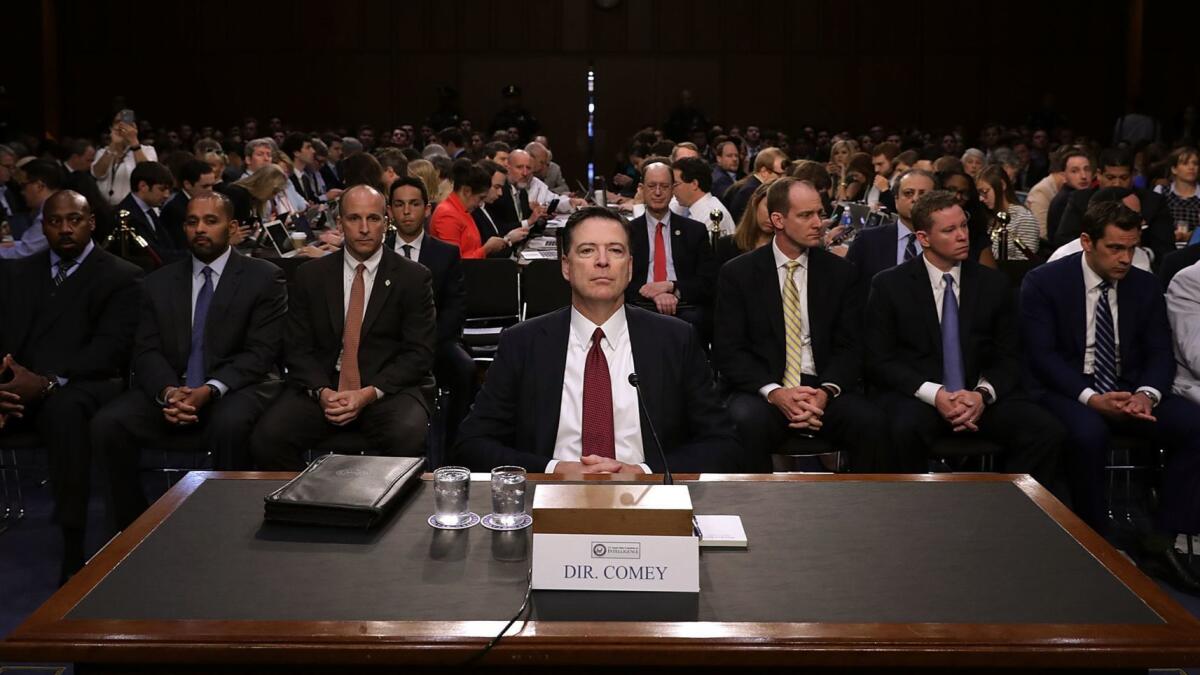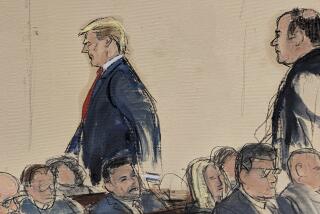Here’s the evidence for the obstruction case that was never made against President Trump

Special counsel Robert S. Mueller III didn’t reach a conclusion on whether President Trump committed a crime by trying to interfere with the Russia investigation. But Mueller outlined the evidence in the redacted report released Thursday.
Mueller looked at 10 specific incidents of possible obstruction of justice. Here are the main ones.
February 2017 | Pressuring Comey on Flynn’s case
One day after Trump ousted Michael T. Flynn as his national security advisor, the president had a private meeting with FBI Director James B. Comey. Flynn was under investigation for lying about his discussions with the Russian ambassador; he later pleaded guilty. Comey later told Congress that Trump asked him to back off the case — comments that Comey interpreted as an effort to quash the investigation. Trump denied it.
According to Mueller’s report, Comey was correct. Trump did ask Comey to close the FBI investigation into Flynn, but he didn’t issue a direct order. Evidence suggests the president knew Flynn could be charged for lying to the FBI and that he believed that firing Flynn would end what he described as “the whole Russia thing.”
“The President’s decision to meet one-on-one with Comey contravened the advice of the White House Counsel that the President should not communicate directly with the Department of Justice to avoid any appearance of interfering in law enforcement activities. And the President later denied that he cleared the room and asked Comey to ‘let[] Flynn go’—a denial that would have been unnecessary if he believed his request was a proper exercise of prosecutorial discretion.”
March 2017 | Leaning on intelligence officials
Trump also pressed top intelligence officials for help shielding Flynn from the FBI investigation. The president allegedly asked Director of National Intelligence Daniel Coats and then-CIA Director Michael R. Pompeo to intervene with Comey.
According to Mueller’s report, in the weeks after Comey testified to Congress about the Russia investigation on March 20, 2017, Trump repeatedly asked intelligence officials to push back publicly on any suggestion he was connected to Russia’s efforts to sway the election. But those officials had different recollections of what the president said.
Pompeo said he had no memory of the meeting, but he did recall Trump urging officials to make it clear that he hadn’t done anything wrong in regard to Russia. Coats said Trump did not ask him to speak with Comey or to help end the investigation. Comey said Trump asked him to “lift the cloud” of the Russia probe. Adm. Michael Rogers, who then headed the National Security Agency, said Trump asked him to refute stories in the press linking him to the Russia investigation. Rogers and NSA Deputy Director Richard Ledgett found the conversation so unusual that they documented it and placed the signed memorandum in a safe.
But Mueller concluded Trump’s comments did not amount to direct intervention. “The evidence does not establish that the President asked or directed intelligence agency leaders to stop or interfere with the FBI’s Russia investigation.”

May 2017 | Firing Comey
Trump asked Justice Department leaders to lay out reasons for firing Comey. At first, White House officials said Comey was dismissed for mishandling the investigation into Hillary Clinton’s use of a private email server. But Trump later told NBC News that he had decided to fire Comey prior to consulting the Justice Department, citing what he called “this Russia thing.”
For Trump’s critics, Comey’s firing was de facto evidence of obstruction of justice.
According to Mueller’s report, evidence suggests Trump fired Comey chiefly because the FBI director was unwilling to publicly state that the president was not under investigation. The president wanted to put the probe behind him, in part because he was concerned it might grow into an inquiry into his campaign and personal life.
“The evidence does not establish that the termination of Comey was designed to cover up a conspiracy between the Trump Campaign and Russia,” the report states. “But the evidence does indicate that a thorough FBI investigation would uncover facts about the campaign and the President personally that the President could have understood to be crimes or that would give rise to personal and political concerns.
June 2017 | Attempting to fire Mueller
After Trump fired Comey, Deputy Atty. Gen. Rod Rosenstein appointed Mueller as special counsel in an effort to protect the investigation from outside interference. One month later, according to news accounts, Trump ordered White House Counsel Donald McGahn to remove him, but McGahn ignored the order. Trump later denied the story.
According to the report, Trump called McGahn twice to ask him to remove Mueller. McGahn recalled Trump telling him, “Mueller has to go” and “Call me back when you do it.” McGahn said he felt “worn down” by the president and “trapped.” He decided to resign rather than carry out the order, but two of Trump’s advisors urged him to not to quit. McGahn returned to work, and Trump did not ask if he fired Mueller.
The attempted firing reflected Trump’s fury at Mueller’s appointment. When he first learned the news, the report said, Trump slumped in his chair and cursed. “Oh my God,” the president said. “This is terrible. This is the end of my Presidency. I’m fucked.”
The report states: “Substantial evidence indicates that the President’s attempts to remove the Special Counsel were linked to the Special Counsel’s oversight of investigations that involved the President’s conduct — and, most immediately, to reports that the president was being investigated for potential obstruction of justice.”
June 2017 | Trying to limit the investigation’s scope
According to the report, on June 19, 2017, Trump met with Corey Lewandowski and asked him to deliver a dictated message to Atty. Gen. Jeff Sessions, telling him to publicly announce that the Mueller investigation would be confined only to future election inference. The president repeated his request a month later. Sessions ignored the request.
The report states: “Substantial evidence indicates that the President’s efforts to have Sessions limit the scope of the Special Counsel’s investigation to future election interference was intended to prevent further investigative scrutiny of the President’s and his campaign’s conduct.”
July 2017 | Drafting a false statement
In June 2016, during the presidential campaign, Donald Trump Jr. accepted a meeting at Trump Tower with a Russian lawyer after being told she had incriminating information on Hillary Clinton. Paul Manafort, Trump’s campaign chairman, and Jared Kushner, his son-in-law and advisor, also attended.
When the New York Times revealed the meeting in July 2017, the president worked with his son to draft a statement falsely claiming the purpose of the meeting was to discuss Russian adoption policy.
Mueller found that, on three occasions, Trump directed his staff not to disclose information about the meeting, and that he dictated a false account of it for release by his son. These acts could be considered obstructive if aimed at withholding information from or misleading congressional investigators or the special counsel. But Mueller found the president was primarily intent on lying to the press.
“The evidence does not establish that the President took steps to prevent the emails or other information about the June 9 meeting from being provided to Congress or the Special Counsel,” the report states. “The series of discussions in which the President sought to limit access to the emails and prevent their public release occurred in the context of developing a press strategy.”
November 2018 | Pushing out Sessions
Trump had long raged against his first attorney general, Jeff Sessions, for recusing himself from the Russia investigation, believing Sessions should have kept control to protect the president. On Nov. 7, 2018, one day after the midterm election, Trump finally ousted Sessions and installed a loyalist, Matthew Whitaker, as his temporary replacement. Critics were quickly concerned that Trump was moving to clamp down on the investigation.
Mueller’s report details Trump’s efforts to get Sessions to reverse his recusal so that Sessions would retain control of the probe and could restrict its scope. From Trump’s statements and actions, the report says, it’s reasonable to infer that he believed “an unrecused Attorney General would play a protective role and could shield the President from the ongoing Russia investigation.”
December 2018 | Blasting people who cooperate
Trump criticized the Russia investigation as a “witch hunt” and a “hoax” from the start, but he also targeted witnesses who cooperated with prosecutors. On one day in December, he urged a stiff prison sentence for Michael Cohen, his former lawyer who had reached a plea deal, and praised Roger Stone, a longtime political advisor who pledged not to testify against him, for having “guts.”
Mueller’s report says Trump repeatedly urged Cohen not to “flip.” When Cohen ultimately cooperated with investigators, the president called him a “rat” and publicly suggested that members of Cohen’s family had committed crimes.
The report states: “The evidence concerning this sequence of events could support an inference that the President used inducements in the form of positive messages in an effort to get Cohen not to cooperate, and then turned to attacks and intimidation to deter the provision of information or undermine Cohen’s credibility once Cohen began cooperating.”
More to Read
Get the L.A. Times Politics newsletter
Deeply reported insights into legislation, politics and policy from Sacramento, Washington and beyond. In your inbox three times per week.
You may occasionally receive promotional content from the Los Angeles Times.








